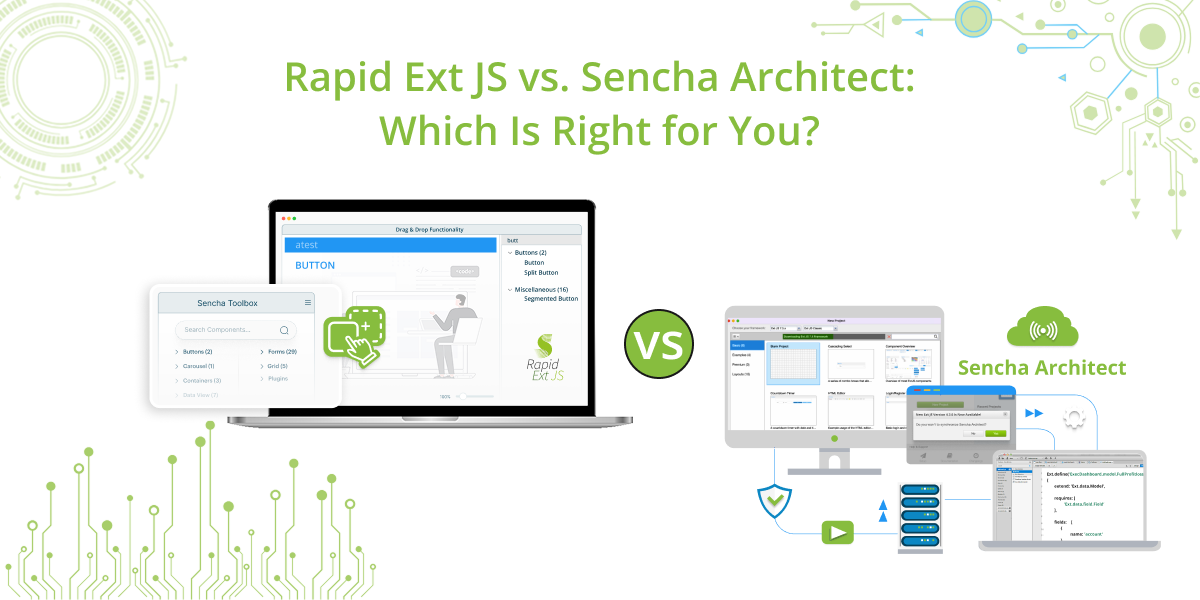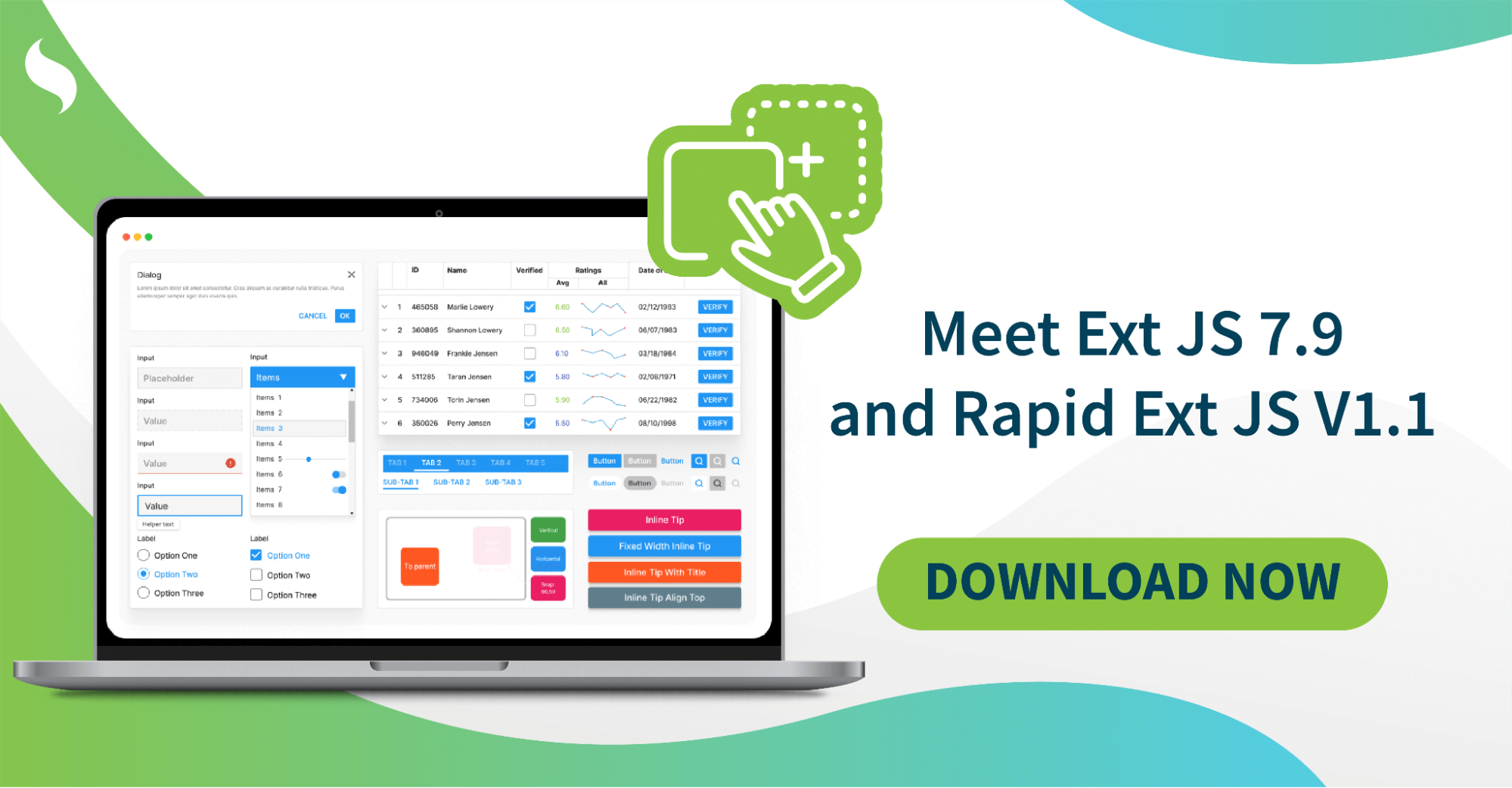How UI Components Help Developers Create Scalable and User-Friendly Web Apps
Creating scalable and easy-to-use applications is a key goal in web development. These applications align with user expectations. As businesses grow, the number of users increases. It is expected that the app will handle more traffic. The app must also work smoothly on various platforms.

UI components play a significant role here. They are simple building blocks of the application. These are easy to create and reuse across the application.
A UI component creates interfaces that are uniform and easy to maintain. They include basic elements like buttons and navigation bars. These elements can be styled and integrated quickly. This reduces code duplication. It also maintains brand consistency across platforms.
The strength of Ext JS UI components lies in enabling scalable applications. They assist in building complex interfaces. They reduce application load and streamline team processes. Developers can focus more on feature development. Less time is spent on non-beneficial tasks.
Let’s explore how UI components aid in scaling applications. They help create user-friendly and efficient applications. UI components are crucial for web development. They expedite creation and simplify future upkeep. Let’s explore more about these components.
What are UI Components?
Web applications use many UI components. These are pre-designed, reusable elements. Examples include buttons file, input fields, and checkboxes. They also include data grids, modals, and menus. Each component serves a specific purpose. It may capture information, display content, or enable user interaction. These components form a crucial part of modern web application development.
UI components are reusable elements. They are not unique to a single application. This consistency benefits design and functionality. Developers avoid recreating UI elements for every application. Instead, they use available components to minimize errors. Tools like Sencha Architect further simplify this process by offering powerful design and development capabilities for user interface creation.
Frameworks like Ext JS application development software offer ready-made components for desktop applications. These emphasize usability, accessibility, and performance. They help developers create appealing and streamlined web applications. Additionally, integrating components with a robust data layer ensures seamless data handling and enhances functionality. Features like data visualization make these frameworks even more versatile.
For enterprise-grade websites, Sencha Cmd and Sencha GXT provide advanced tooling for optimizing and building high-performance solutions. These tools support efficient development workflows, making it easier to maintain scalability and performance in complex projects.

Benefits of Using UI Components in Web Development
UI components offer several key benefits for web development MVC.
Faster Development Cycles
CSS UI components integration save time by eliminating the need to develop them from scratch. For example, a data grid with sorting and filtering capabilities saves significant time.
Consistency in Design Across Applications
UI components ensure uniform performance across application pages. For instance, a navigation bar created once can be reused across pages without issues.
Improved Code Reusability and Maintenance
UI components prevent code duplication. They make maintaining compliance easier across projects. For example, a date-sorting tool can be used in multiple forms. Changes made to the tool apply seamlessly across all applications.
How UI Components Help to Create Scalable Web Applications
Developing applications for growth and high user demands is challenging. UI components address these issues. They support performance and scalability. New applications can launch smoothly and adapt to growth. Let’s explore how UI components can help create scalable web applications.
Handling Complex Interfaces with Ease
Applications grow in complexity as they scale. UI components help manage this complexity. Developers can rely on ready-made components. These serve specific purposes, such as input forms or data lists.
For instance, data grids display large datasets with sorting and paging functions. This reduces the need for custom coding for every interaction. Managing complex interfaces becomes much simpler.
Optimized Performance for High-Scale Applications
When scaling upwards, performance is a core component. UI components are often performance-oriented. The aim is to reduce manual coding and process complexity. Many components use strategies like lazy loading and data virtualization.
For example, in a data grid, only the visible cells in the viewport are displayed. This increases screen loading speed and minimizes content in use. This is especially meaningful for applications with large data volumes. Optimized components ensure new apps meet performance standards under heavy loads.
Simplifying Collaboration in Development Teams
Collaboration in larger teams can be difficult. Multiple developers often work on different application sections simultaneously. UI components make collaboration easier.
They provide common basic elements for all team members to interact with. This limits design and functionality differences. When members use the same components, processes speed up. The team stays on the same page. Less discussion is needed about design decisions.
In agile environments, this consistency is essential. It reduces time spent in discussions and allows faster iterations.
Extending Scalability with ReExt
UI components enhance application scalability. Ext JS provides sophisticated, easy-to-implement components. ReExt adds more extensibility to Ext JS.
Developers can modify or create new UI components with ReExt. These components suit the needs of matured applications. This is crucial as applications grow larger.
ReExt ensures the application remains scalable for new requirements. Developers can enhance performance and add features as needed.
How Ext JS Enhances User-Friendly Web Applications
Ext JS is a popular JavaScript framework by Sencha. It enables the creation of interactive and data-driven web applications.
The framework offers pre-defined UI components that can be quickly dragged and dropped. These include grids, forms, charts, and trees. Most components are performance-optimized and user-friendly.
Ext JS enhances user experience with ready-to-use features. For example, sorting, filtering, and pagination require little to no custom coding. This ensures a consistent and seamless user experience.
The framework supports responsive design. Applications adjust their interfaces to specific device screens. Layout managers position components for better accessibility. This simplifies processes and improves usability.
Ext JS integrates UI with backend data through a robust data package. Real-time updates make applications engaging and interesting.
Theming and customization options allow developers to adjust application appearance. Cross-browser functionality ensures consistent performance. This increases usability across platforms.
Ext JS reduces the complexity of development activities. It balances performance with user experience. Developers can build effective, enterprise-level web applications faster.

Real-World Examples and Case Studies of Successful UI Organization
Apple: Simplicity and Functionality
Apple excels in simplicity and functionality. macOS and iOS icons are structured and identifiable. Gesture-based navigation is simple and intuitive. The iPhone home page showcases all applications for straightforward access. The design ensures ease of use for all users.
Google Search: Minimalism in Action
Google Search exemplifies minimalism in UI. The design revolves around one purpose: searching. A single search bar focuses user attention. This reduces extra information and simplifies the interface. It makes the application accessible to billions globally.
Netflix: Prioritizing Content Discovery
Netflix organizes content into intuitive UIs. Carousel menus enable physical navigation. Personalized recommendations help users discover content. Features like “Continue Watching” simplify the user experience.
Amazon: E-Commerce Efficiency
Amazon handles complex UIs effectively. Filters, categories, and a search bar assist users. Finding products is quick and straightforward. Features like “Customers also viewed” drive additional sales. The design aligns with user needs and business goals.
Slack: Streamlined Collaboration
Slack simplifies a complex workspace with an organized layout. The sidebar displays channels and direct messages. Users can navigate effortlessly. Its design combines functionality with an approachable interface.
Wrap Up
UI components are essential in modern web development. They provide modular and reusable building blocks for applications. Developers can use them to create scalable and user-friendly interfaces. Pre-built elements like buttons, forms, and data grids save time. They reduce redundancy and speed up the development process.
UI components ensure consistency across applications. They also optimize performance using techniques like lazy loading. This is critical for handling large-scale applications effectively.
Collaboration becomes easier with standardized components. Teams can align quickly and avoid inconsistencies. Frameworks like Ext JS enhance scalability with advanced features. UI components enable developers to deliver efficient and user-focused web applications.
FAQs
How does Ext JS support accessibility and modern web standards?
Ext JS supports ARIA roles for accessibility. It enables keyboard navigation. Screen readers are fully compatible.
What types of applications are best suited for Ext JS?
Ext JS works best for enterprise web applications. It suits data-heavy dashboards. It’s great for responsive, complex UIs.
What are some key UI components for scalable web apps?
Data grids handle large datasets. Charts visualize data efficiently. Forms and navigation bars improve functionality. Modals enhance interactivity.
How do UI components improve user experience?
UI components create consistent designs. They simplify navigation. They improve responsiveness. This makes applications easier to use.
Supercharge Your Web Apps with Ext JS – Build Scalable, User-Friendly Interfaces Faster Than Ever!

When it comes to developing robust, enterprise-grade web applications, Sencha provides some of the most…

The Sencha team is excited to announce the latest Ext JS version 7.9 and Rapid…

It is important to select the best app development software with proper instructions that enhance…










